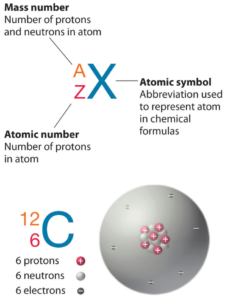Californium is an actinide element, the sixth transuranium element to be synthesized, and has the second-highest atomic mass of all the elements that have been produced in amounts large enough to see with the unaided eye (after einsteinium). The most commonly used spontaneous fission neutron source is the radioactive isotope californium-252. Cf-252 and all other spontaneous fission neutron sources are produced by irradiating uranium or another transuranic element in a nuclear reactor.
Protons and Neutrons in Californium
 Californium is a chemical element with atomic number 98 which means there are 98 protons in its nucleus. Total number of protons in the nucleus is called the atomic number of the atom and is given the symbol Z. The total electrical charge of the nucleus is therefore +Ze, where e (elementary charge) equals to 1,602 x 10-19 coulombs.
Californium is a chemical element with atomic number 98 which means there are 98 protons in its nucleus. Total number of protons in the nucleus is called the atomic number of the atom and is given the symbol Z. The total electrical charge of the nucleus is therefore +Ze, where e (elementary charge) equals to 1,602 x 10-19 coulombs.
The total number of neutrons in the nucleus of an atom is called the neutron number of the atom and is given the symbol N. Neutron number plus atomic number equals atomic mass number: N+Z=A. The difference between the neutron number and the atomic number is known as the neutron excess: D = N – Z = A – 2Z.
For stable elements, there is usually a variety of stable isotopes. Isotopes are nuclides that have the same atomic number and are therefore the same element, but differ in the number of neutrons. Mass numbers of typical isotopes of Californium are 248-254.
Main Isotopes of Californium
Californium does not occur in natural isotope.
Naturally Occuring Isotopes
| Isotope | Abundance | Neutron Number |
| – | – | – |
Typical Unstable Isotopes
| Isotope | Half-life | Decay Mode | Product |
| 248Cf | 333.5 d | alpha decay or spontaneous fission | 244Cm or – |
| 249Cf | 351 y | alpha decay or spontaneous fission | 245Cm or – |
| 250Cf | 13.08 y | alpha decay or spontaneous fission | 246Cm or– |
| 251Cf | 898 y | alpha decay | 247Cm |
| 252Cf | 2.645 y | alpha decay or spontaneous fission | 248Cm or– |
| 253Cf | 17.81 d | beta decay or alpha decay | 253Es or 249Cm |
| 254Cf | 16.5 d | spontaneous fission or alpha decay | – or 250Cm |
Electrons and Electron Configuration
The number of electrons in an electrically-neutral atom is the same as the number of protons in the nucleus. Therefore, the number of electrons in neutral atom of Californium is 98. Each electron is influenced by the electric fields produced by the positive nuclear charge and the other (Z – 1) negative electrons in the atom.
Since the number of electrons and their arrangement are responsible for the chemical behavior of atoms, the atomic number identifies the various chemical elements. The configuration of these electrons follows from the principles of quantum mechanics. The number of electrons in each element’s electron shells, particularly the outermost valence shell, is the primary factor in determining its chemical bonding behavior. In the periodic table, the elements are listed in order of increasing atomic number Z.
Electron configuration of Californium is [Rn] 5f10 7s2.
Possible oxidation states are +3.
Summary
| Element | Californium |
| Number of protons | 98 |
| Number of neutrons (typical isotopes) | 248-254 |
| Number of electrons | 98 |
| Electron configuration | [Rn] 5f10 7s2 |
| Oxidation states | +3 |
Source: www.luciteria.com












